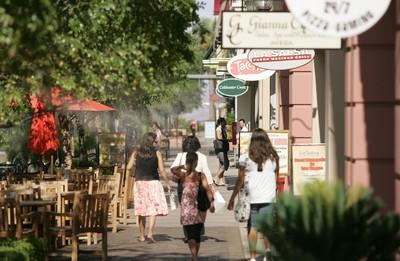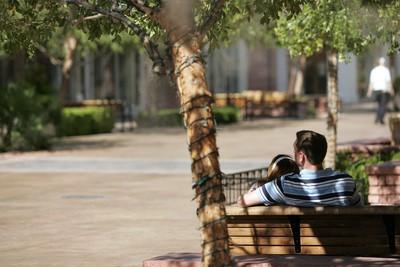HOT BUT NOT BOTHERED
It may melt their hair spray, but the oppressive summer heat can't keep Joyce Johnson and her friend, Lois Platz, from their favorite outdoor pastime.
"When you get focused on shopping, you don't think about the heat," said Johnson on a recent triple-digit afternoon trip to Las Vegas Premium Outlets, where she scored a white shirt and a pair of terra-cotta capri pants.
"When you've lived in Las Vegas for as long as we have, you get used to it," Platz added.
In an apparent affront to common sense, the valley's open-air malls thrive in the summer.
"We see a pretty consistent traffic flow all year," says Rob Benson, spokesman for The District at Green Valley Ranch, which -- like all shopping centers contacted by the R-J -- does not release specific sales figures. "Even though it's 100-plus degrees outside, people are willing to go out and live their lives."
"I'm sure that there are some people who wouldn't shop in 115 degrees," said Mike Niemira, director of research for the New York-based International Council of Shopping Centers. "But, it seems that, for the most part, people can take temperature."
The only significant deterrent to shopping, Niemira said, is precipitation -- of which Las Vegas has relatively none.
"Perhaps it's a driving issue," he explained.
Nationally, outdoor malls outstrip indoor ones in sales per square foot, a common measure for retail success. (In 2005, the last year surveys were taken by ICSC, outdoor malls averaged $274.89, indoor ones $254.16.)
This is one of many reasons that, of the 17 large (greater than 700,000-square-foot) shopping centers opened in the United States since 2005, only three were indoor.
The concept of the outdoor supermall -- or "lifestyle center," as it's known in industry parlance -- was introduced in the late '80s.
"But it really didn't pick up until about 1997, and it's really been profuse since then," said Randy Shearin, editor of the Atlanta-based Shopping Center Business. "This is the way the industry's going now."
Indeed, the trend may be even more pronounced in the valley because suburban casinos such as Red Rock Resort, the Suncoast and Sante Fe Station already serve the function of indoor malls to local residents.
"Las Vegas is definitely a unique market in that respect," Niemira agreed.
Three large shopping centers currently are under construction in the valley: the 700,000-square-foot Village at Queensridge and the 1.6 million-square-foot Shops at Summerlin Centre in Summerlin, and the 1.5 million-square-foot Town Square south of the Mandalay Bay.
All are outdoor and will employ heat-coping mechanisms such as building blocking, overhanging second stories and passive cooling towers.
"If you take a look, most of the year, at the amount of pedestrian traffic up and down the Strip, people like to be outdoors and be able to interface with the outdoors," said Frank Pankratz, president of Executive Home Builders, the company constructing the Village at Queensridge. "And some of the most successful restaurants in Las Vegas have indoor and outdoor aspects."
"They're the future," Howard Hughes Corporation spokesman Tom Warden said of outdoor malls. His company is building Summerlin Centre on a 107-acre site adjacent to Red Rock Resort.
"If you've got 10 months of very comfortable weather, it makes sense to build a center that is more urban in nature," Warden said.
Warden's use of the word "urban" refers to the belief that shopping centers function best when positioned as artificial downtowns in suburbia.
"It's this whole Main Street phenomenon," Shearin said. "They want to create a 'there' there. And it does help create a sense of place."
Outdoor malls are also more convenient to the consumer, according to Shearin.
"You can drive right up to a store in your climate-controlled car, get out, walk in and then walk back out to your car," he said. "It's a lot more convenient than parking in a parking lot and walking across it."
Perhaps the biggest reason builders favor outdoor malls, however, is cost.
"They tend to spend more on the ambience -- the landscaping and the outdoor elements -- but they're cheaper to build because you're not building that big roof," Shearin said. "And they're less expensive to operate, because you don't have to air-condition the entire area."
There is some hope for sun-phobic shopaholics, however.
"This is still the architecture business," Niemira said. "What's in one year can very well be out the next."
And that's good news to Joyce Johnson.
"The truth is, on a day like this, I would rather be at an indoor mall," the shopper said.























